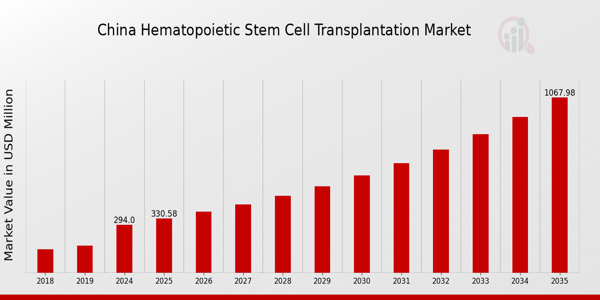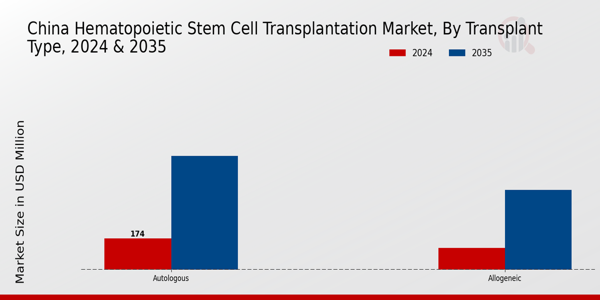China Hematopoietic Stem Cell Transplantation Market Overview
As per MRFR analysis, the China Hematopoietic Stem Cell Transplantation Market Size was estimated at 262.74 (USD Million) in 2023. The China Hematopoietic Stem Cell Transplantation Market Industry is expected to grow from 294(USD Million) in 2024 to 1,068 (USD Million) by 2035. The China Hematopoietic Stem Cell Transplantation Market CAGR (growth rate) is expected to be around 12.442% during the forecast period (2025 - 2035)
Key China Hematopoietic Stem Cell Transplantation Market Trends Highlighted
The China Hematopoietic Stem Cell Transplantation Market is witnessing several important market trends, driven primarily by increasing incidences of blood-related disorders like leukemia and anemia. The rise in awareness and advancements in medical technology are also contributing to the growth of this market. The Chinese government has prioritized the development of healthcare infrastructure, supporting cellular therapies and stem cell research through funding and policies. This encouragement leads to enhanced clinical capabilities and improves patient outcomes, serving as a key market driver.
Opportunities within this market are substantial, as many healthcare providers are exploring partnerships for research and development to innovate transplantation techniques.Additionally, the aging population in China is driving the demand for hematopoietic stem cell transplants, creating a need for more treatment centers. Increasing investments in biotechnology firms focusing on stem cell research also indicate the potential for new and advanced therapies. In recent times, trends such as the rise of private stem cell banks and improved regulatory frameworks for transplants are gaining traction.
The local production of stem cell products is on the rise, shaped by supportive governmental policies and the growing emphasis on biomanufacturing capabilities. Enhanced training programs for healthcare professionals are being developed, aiming to bridge skills gaps in this specialized area of medical treatment.Overall, the combination of supportive policies, technological advancements, and a growing patient base characterizes the rapidly evolving landscape of the hematopoietic stem cell transplantation market in China.

Source: Primary Research, Secondary Research, Market Research Future Database and Analyst Review
China Hematopoietic Stem Cell Transplantation Market Drivers
Increasing Incidence of Hematological Disorders
One of the main factors propelling the China Haematopoietic Stem Cell Transplantation Market Industry is the growing prevalence of haematological illnesses, especially in China. The People's Republic of China's National Health Commission estimates that leukemia accounted for roughly 29,000 of the approximately 1.1 million new cancer cases that were recorded in 2020. Since these patients need efficient treatment choices like stem cell treatments, the concerning rise in haematological malignancies increases the demand for haematopoietic stem cell transplantation.
Furthermore, developments in medical technology and treatment methods backed by groups like the Chinese Society of Haematology highlight how urgent it is to create and improve transplantation programs in order to accommodate the growing patient population. These developments are essential for meeting the increasing need for efficient treatments for haematological illnesses, which will accelerate market expansion.
Government Support and Initiatives
The Chinese government's commitment to enhancing the healthcare infrastructure plays a pivotal role in the growth of the China Hematopoietic Stem Cell Transplantation Market Industry. Through initiatives such as the 13th Five-Year Plan for National Health and Family Planning, the government aims to expand access to advanced medical treatments, including stem cell transplantation. These initiatives often lead to increased funding for Research and Development (R&D) and improved hospital resources that support transplantation efforts.
Furthermore, the increased establishment of accredited transplant centers and better access to donor registries has been reported by the China Marrow Donor Program, making it easier for patients to receive timely treatments. The collaboration between government entities and healthcare organizations is vital for promoting awareness about the benefits of stem cell transplantation, thereby stimulating further market growth.
Growing Awareness and Acceptance of Stem Cell Therapies
As public awareness about the potential of hematopoietic stem cell therapies grows, acceptance among patients in China increases. Educational campaigns led by non-profit organizations and hospitals focusing on the importance of stem cell transplants for treating life-threatening conditions enhance the understanding among patients and their families regarding the benefits of the procedure.
The involvement of the Chinese Society of Hematology in disseminating information about stem cell transplantation and the positive outcomes associated with such treatments inspires confidence in patients, leading to a greater likelihood of considering these options.Reports suggest that approximately 85% of parents surveyed were open to the idea of stem cell therapy for their children with hematological disorders, which correlates with the expanding market for stem cell transplantation solutions.
China Hematopoietic Stem Cell Transplantation Market Segment Insights
Hematopoietic Stem Cell Transplantation Market Transplant Type Insights
The China Hematopoietic Stem Cell Transplantation Market exhibits significant growth within the Transplant Type segment, which includes Allogeneic and Autologous transplants. Allogeneic transplants involve the use of stem cells from a genetically similar donor, making it a critical choice for treating various hematological diseases due to its adaptability and the potential to address complications such as graft-versus-host disease.
This approach harnesses the advantages of donor immune responses against residual leukemic cells, driving its importance in complicated cases.The increasing prevalence of blood disorders in China has led to a heightened demand for such transplant methods, supported by advancements in matching techniques and increased awareness of donor registries.
Conversely, Autologous transplants utilize the patient's own stem cells and play a crucial role in minimal residual disease settings. This technique is often preferred due to lower risks of complication from graft rejection and is growing in significance as patients and healthcare providers recognize its effectiveness in addressing conditions like lymphoma and certain myelomas.The rise of new therapeutic techniques and improved conditioning regimens are expected to further bolster interest in both transplant methods.
Amidst the challenges posed by sourcing compatible donors for Allogeneic procedures, innovations in stem cell collection and transplant logistics offer opportunities for enhancing patient access and outcomes across the region. Therefore, while there are evident hurdles in both approaches, ongoing Research and Development in the China Hematopoietic Stem Cell Transplantation Market fuels optimism for better efficacy and broader application of both Allogeneic and Autologous transplants.The understanding and implementation of these transplant types remain central to the evolving landscape of hematologic treatments in China, showcasing a market poised for continuous growth and advancement.

Source: Primary Research, Secondary Research, Market Research Future Database and Analyst Review
Hematopoietic Stem Cell Transplantation Market Indication Insights
The China Hematopoietic Stem Cell Transplantation Market, particularly within the Indication segment, showcases a diverse landscape driven by various types of hematological malignancies and disorders. Among these, Acute Myeloid Leukemia and Acute Lymphoblastic Leukemia represent significant areas of focus due to their aggressive nature and increasing prevalence in the country. The incidence of these leukemias continues to rise, necessitating effective treatment options and leading to a robust demand for hematopoietic stem cell transplant procedures.Meanwhile, Hodgkin Lymphoma and Non-Hodgkin Lymphoma are prominent in the context of lymphoproliferative disorders, where stem cell transplantation plays a critical role in therapeutic strategies.
Multiple Myeloma also stands out, as its complexities and evolving treatment protocols present opportunities for innovative therapies in the market. Additionally, the segment encompasses Other Non-Malignant Disorders, which, while less frequent, emphasizes the broad application of hematopoietic stem cell transplantation in treating a range of ailments beyond cancer.Overall, the Indication segment of the China Hematopoietic Stem Cell Transplantation Market is characterized by its pivotal role in addressing urgent healthcare needs in oncology and providing hope for patients dealing with serious conditions.
Hematopoietic Stem Cell Transplantation Market Application Insights
The China Hematopoietic Stem Cell Transplantation Market is experiencing significant growth, driven by advances in medical technology and increasing incidences of hematological disorders. The application segment includes various methods such as Bone Marrow Transplant, Peripheral Blood Stem Cells Transplant, and Cord Blood Transplant, each playing a vital role in therapeutic interventions. Bone Marrow Transplant remains crucial for treating conditions like leukemia and lymphoma, as it offers a potentially curative approach by restoring healthy blood cell production.Peripheral Blood Stem Cells Transplant is becoming increasingly popular due to its less invasive procedure and quicker recovery times compared to traditional methods.
Cord Blood Transplant represents a growing area of interest, especially in pediatric cases, as it utilizes hematopoietic stem cells that are rich in immunological properties and can provide life-saving treatments for various diseases. The combination of these techniques showcases the diversity within the application segment, addressing different patient needs and preferences, thereby reflecting the robust nature of the China Hematopoietic Stem Cell Transplantation Market segmentation.As the healthcare infrastructure continues to improve in China, the adoption of these transplantation methods is expected to increase, responding effectively to the rising demand for innovative treatments.
China Hematopoietic Stem Cell Transplantation Market Key Players and Competitive Insights
The China Hematopoietic Stem Cell Transplantation Market is characterized by significant advancements and robust competition among various healthcare institutions, specialized medical facilities, and biological research centers. As the market expands, driven by increasing incidences of hematological disorders and advancements in transplant techniques, numerous players are vying for supremacy. Innovative research, technological advancements in transplantation procedures, and an increasing focus on improving patient outcomes play a pivotal role in shaping the competitive landscape.
Market dynamics are influenced by factors such as regulatory policies, availability of skilled professionals, and public awareness regarding hematopoietic stem cell transplantation, which enhances the competitive edge of leading entities.Beijing Tsinghua Changgung Hospital stands out in the China Hematopoietic Stem Cell Transplantation Market due to its strong reputation for excellence in medical care, research capabilities, and comprehensive treatment options. The hospital's commitment to advancing hematopoietic stem cell transplantation is reflected in its state-of-the-art facilities and experienced medical personnel who are actively engaged in transplant research and clinical trials.
With a focus on integrating innovative techniques and personalized treatment regimens, Beijing Tsinghua Changgung Hospital has established a formidable presence.
Its strengths lie in its affiliations with prestigious academic institutions, which enhance its research initiatives and patient care protocols, thereby consolidating its position in the rapidly evolving market.Harbin Medical University plays a crucial role in the China Hematopoietic Stem Cell Transplantation Market by leveraging a strong framework of educational and clinical resources. The university boasts some key products and services related to hematopoietic stem cell transplantation, including specialized training programs, cutting-edge research in transplant biology, and the development of novel therapeutic protocols.
Its market presence is further bolstered by partnerships with leading hospitals and research facilities across China. Harbin Medical University excels in fostering talent, with a focus on expanding its academic offerings and integrating clinical practice with research initiatives. The institution's strategic involvement in partnerships and potential mergers has enabled it to enhance its operational capacity and research capabilities, securing a reputable position within the market landscape.
Key Companies in the China Hematopoietic Stem Cell Transplantation Market Include
- Beijing Tsinghua Changgung Hospital
- Harbin Medical University
- Shenzhen Children's Hospital
- Peking University People's Hospital
- Nanjing Drum Tower Hospital
- Tianjin Medical University General Hospital
- Fudan University Shanghai Cancer Center
- Shanghai Jiao Tong University School of Medicine
China Hematopoietic Stem Cell Transplantation Market Industry Developments
In recent months, the China Hematopoietic Stem Cell Transplantation Market has seen significant developments, particularly with ongoing advancements in treatment methodologies and increasing investments in healthcare infrastructure. Beijing Tsinghua Changgung Hospital has been at the forefront, enhancing its transplant protocols to improve patient outcomes. Harbin Medical University and the West China Hospital have also contributed by expanding their research initiatives in stem cell therapies.
Notably, Shenzhen Children's Hospital has reported increases in pediatric transplant cases, reflecting a growing demand for specialized services. In terms of the market's financial growth, several hospitals, including Peking University People's Hospital and Fudan University Shanghai Cancer Center, have disclosed expansions in their transplantation programs, subsequently increasing their market valuation. Over the past two years, significant activities included new collaborations for Research and Development efforts focused on hematopoietic stem cell innovations, which were highlighted publicly in June 2022.
There have not been any notable merger or acquisition announcements among the listed institutions recently, but continued collaborations are expected to shape the future landscape of this essential medical field in China.
China Hematopoietic Stem Cell Transplantation Market Segmentation Insights
-
Hematopoietic Stem Cell Transplantation Market Transplant Type Outlook
-
Hematopoietic Stem Cell Transplantation Market Indication Outlook
- Acute Lymphoblastic Leukemia
- Other Non-Malignant Disorders
-
Hematopoietic Stem Cell Transplantation Market Application Outlook
- Peripheral Blood Stem Cells Transplant
| Report Attribute/Metric Source: |
Details |
| MARKET SIZE 2023 |
262.74(USD Million) |
| MARKET SIZE 2024 |
294.0(USD Million) |
| MARKET SIZE 2035 |
1068.0(USD Million) |
| COMPOUND ANNUAL GROWTH RATE (CAGR) |
12.442% (2025 - 2035) |
| REPORT COVERAGE |
Revenue Forecast, Competitive Landscape, Growth Factors, and Trends |
| BASE YEAR |
2024 |
| MARKET FORECAST PERIOD |
2025 - 2035 |
| HISTORICAL DATA |
2019 - 2024 |
| MARKET FORECAST UNITS |
USD Million |
| KEY COMPANIES PROFILED |
Beijing Tsinghua Changgung Hospital, Harbin Medical University, West China Hospital, Shenzhen Children's Hospital, Peking University People's Hospital, China Medical University, Wuxi People’s Hospital, Nanjing Drum Tower Hospital, Nanfang Hospital, Ruijin Hospital, Zhongshan Hospital, Tianjin Medical University General Hospital, Fudan University Shanghai Cancer Center, Shanghai Jiao Tong University School of Medicine, Suzhou Sunan Hospital |
| SEGMENTS COVERED |
Transplant Type, Indication, Application |
| KEY MARKET OPPORTUNITIES |
Increasing prevalence of blood disorders, Advancements in transplantation technology, Growing government healthcare investments, Rising awareness and patient education, Expanding cord blood banking services |
| KEY MARKET DYNAMICS |
growing cancer incidence, increasing healthcare investment, advancements in transplantation technology, rise in donor registries, government support and regulations |
| COUNTRIES COVERED |
China |
Frequently Asked Questions (FAQ):
The China Hematopoietic Stem Cell Transplantation Market is expected to be valued at 294.0 USD Million in 2024.
By 2035, the market is projected to be valued at 1068.0 USD Million.
The market is expected to grow at a CAGR of 12.442% from 2025 to 2035.
The Allogeneic transplantation segment is valued at 120.0 USD Million in 2024.
The Autologous transplantation segment is expected to reach 628.0 USD Million by 2035.
The dominant market share is primarily held by major hospitals and medical institutions throughout China.
Key players include Beijing Tsinghua Changgung Hospital, Harbin Medical University, and Shenzen Children's Hospital among others.
Growth drivers include advancements in medical technology and increasing patient demand for stem cell therapies.
Emerging trends include innovations in transplantation techniques and personalized medicine approaches.
Challenges include regulatory hurdles and the need for increased donor registries to meet clinical demands.
















